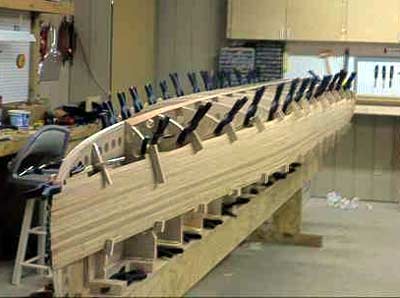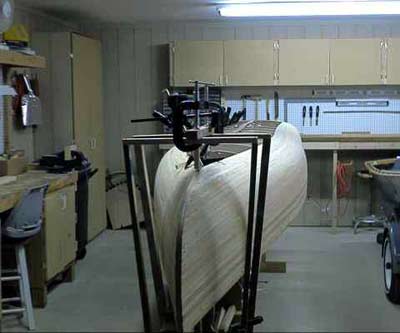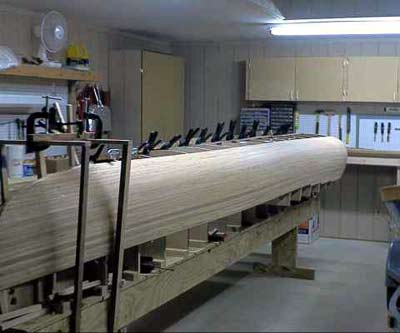April 3
Hey Chuck,
The 1/8" plywood strip canoe was a failure! Even so, I
still think the technique will work. Though it is tedious, it
might be worth while for certain applications - especially Mouse
and Toto sized utralite craft. The problem was massive failure
of the Titebond II glue. It failed at about half the seams,
resulting in a big mess. I can't blame it all on Titebond, they
mean it when they say the temperature must be above 55 degrees
F! We had the heater on while gluing, but turned it off when
finished for the night. I incorrectly guessed the shop would
maintain heat long enough for the glue to cure. Some nights
were well into the low twenties - so it was my fault. The glue
at the failed seams was crystallized to the point that it had
very little adhesive properties. We worked an afternoon trying
to save the hull, but it was no use. There was no practical
way to clamp the seams on the middle strips. So, she got a Viking
burial on the burn pile.
Not giving up THAT easy, we
immediately started another project. Another canoe we call Hawbuck.
It is a highly modified Prospector reminiscent of the square
sterned canoes that were common 70 or 80 years ago. Unlike the
typical canoe with a transom, the Hawbuck maintains its max
beam all the way aft. Tomblehome beginning about four feet from
the transom gives the hull the appearance that the transom narrows,
this effect is compounded by a shear line that mirrors the bow
(to a point) and gives the hull a symmetrical shape like its
canoe cousins. An inch and a half rocker was maintained forward,
none aft. Made to be powered full time, I think she'll easily
take a 9.9hp, although an air-cooled 3.5hp would do the trick
- especially if you were in a situation where you needed to
portage.
Seats will be ash and cane bases
with stadium style seats on top. A couple of special considerations
for power are an extra layer of 6 oz cloth on the outside and
two thwarts instead of the more traditional single thwart (for
a 16 footer). Matt, who is assisting with the construction will
also be the owner/operator, so his personal desires on inwales,
scuppers, deck configuration, and a covered (canvas) storage
area between the thwarts, will make the Hawbuck an original.
Is it still a canoe? I'm not sure, it looks canoeish, but also
has a lot of skiff properties. The transom is a full 17"
high to raise a short shaft outboard to max operating height
(minimizing overall draft). Maybe the "experts" can
say what she is when we lift her off the forms. We are about
ten days beyond these photos and have "rounded the bend",
having yet to mar the hull with a staple. Turns out the experimental
process we were using for the plywood prototype was perfect
for building a traditional strip-built without staples! So it
wasn't an exercise in vain after all!
Larry Pullon


April 9
Here are current pictures of the Hawbuck project.
Note the two frames attached to the strongback near the stems.
These frames allowed Matt and I to use small boards to hold
the strips in place where they twisted the most. The system
worked well and strips can be installed single handedly, although
it was far easier with two sets of hands. Just about all the
strips since the last photo were put on one at a time. At first
I worried the slow pace would be boring, but now I find I'm
building a boat with hardly any impact on all the other things
we have to do around the house - low impact boat building!
As soon as Matt sands for a week or two (it is
HIS boat) we'll start making the cane seats and other components.




